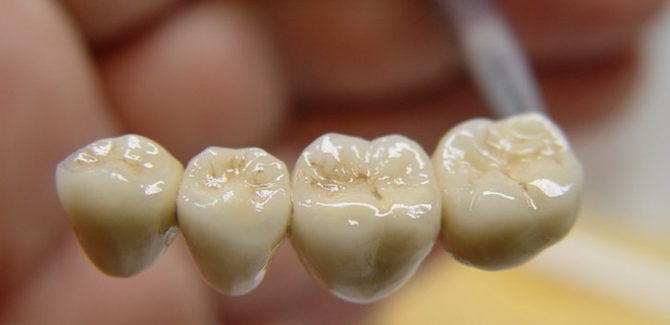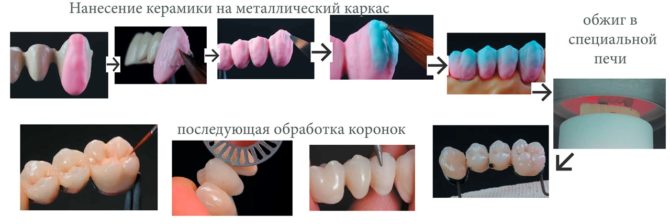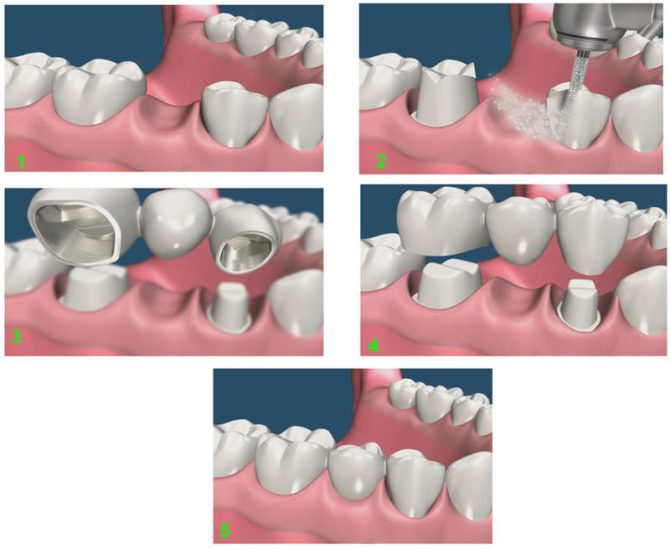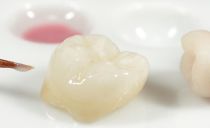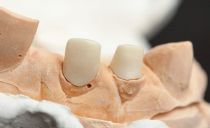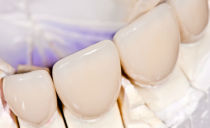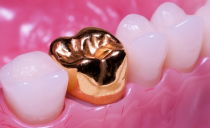Ceramic prosthetics, the pros and cons of ceramic-metal crowns
Metal-ceramic prosthetics is the best method for restoring the integrity and functionality of the dentition. Ceramic-metal crowns are made of two components - a cast metal frame and an outer ceramic layer. The base can be made of various metal alloys that are not oxidized by saliva. The color of the outer ceramic part is selected in accordance with the shade of the natural enamel of the adjacent teeth, which allows to give the crown maximum naturalness.
Content
Production of ceramic-metal prosthesis
The procedure for manufacturing a prosthesis made of cermet consists of several stages, including mandatory intermediate control of compliance with the needs of the patient. First, the doctor makes a special impression of the patient’s dentition from a special hardening mass, on the basis of which a plaster cast of the jaw is cast. The metal frame of the structure is modeled from wax, and then sent to a foundry, where the base is cast from the declared metal compounds.
The finished metal base is tried on, adjusted if necessary and returned to the dental technicians for applying the ceramic coating. The ceramic coating is applied to the metal frame in layers, the shape of the future tooth is determined by the technologist in accordance with the individual cast of the patient's jaw. The work is done manually, which allows you to accurately repeat the natural shape of the tooth.
To give the product strength and strengthen the chemical bond between the components of the materials after applying the ceramic, the prosthesis is fired in a special furnace at a temperature of 800–900 ° C. On top of the structure is covered with a thin layer of special enamel, corresponding to the shade of natural.
Then the final fitting is carried out: the correspondence of the crown to the color of natural enamel and the anatomical features of the patient's jaw is checked. Only after this the crown is covered with shiny glaze and subjected to final firing.
Varieties of metal-ceramic crowns
Depending on the manufacturing technology, there are 3 types of metal-ceramic dentures:
- Stamped crowns. The metal base is made by stamping. There may be a discrepancy in the shape of the product to the anatomical features of the client's jaw. Prosthetics with stamped crowns is the most unreliable, its only advantage is lower cost.
- Milled crowns. Fully consistent with the individual characteristics of the dentition of the patient.
- Ceramic-metal crowns with shoulder mass. They are the most reliable and ergonomic. By reducing the volume of the metal base, the proportion of the ceramic part is increased, which increases the strength of the structure and improves its aesthetic indicators.
Pros and cons of cermet teeth
Metal-ceramic prosthetics are recommended by practicing dentists to eliminate many dental problems. The claimed method is made acceptable cost, reliability and the ability to install ceramic-metal crowns for chronic diseases of the oral cavity of mild and moderate severity.
The main advantages of cermets are:
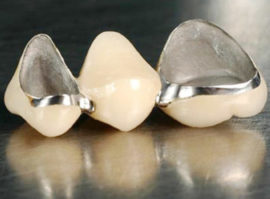 Visual and functional identity of natural teeth. Ceramic-metal prostheses repeat the individual form of dental crowns, the color and texture of enamel. Reconstruction of the anatomical form of the dentition allows you to fully restore speech and chewing function. Ceramic-metal prostheses can be installed even in the case of complete adentia.
Visual and functional identity of natural teeth. Ceramic-metal prostheses repeat the individual form of dental crowns, the color and texture of enamel. Reconstruction of the anatomical form of the dentition allows you to fully restore speech and chewing function. Ceramic-metal prostheses can be installed even in the case of complete adentia.- Strength and wear resistance. Ceramic metal dental is resistant to all types of wear: it is not subject to crumbling, abrasion, crushing. The metal frame has maximum strength, therefore, withstands the load exerted on the chewing teeth, and is not subject to external factors.
- Universality. Ceramic prosthetics are used to restore all types of teeth. With their help, the front teeth, lateral incisors, fangs, molars and premolars are restored. You can perform prosthetics as one or more teeth, and the entire dentition.
- Preservation of the roots of supporting teeth. The strength of the abutment teeth is somewhat reduced due to the turning that needs to be done when installing a prosthesis made of cermet, but the equipment used in modern dentistry allows you to save the maximum amount of your own hard tissues.
- Durability. The service life of metal-ceramic dentures is from 10 to 17 years. How much they will serve depends on the type of materials used and the quality of the installation.
The ceramic surface does not absorb coloring substances, therefore artificial teeth do not darken, do not turn yellow and do not fade over time under the influence of pigmented food, colored drinks and nicotine.
- Minimum probability of implant rejection after prosthetics.
- Quick adaptation. Due to the fact that the cermet structures follow the shape of the patient’s teeth, the functionality of the dentition is restored immediately. The texture of the prosthesis also corresponds to natural enamel, therefore, within a week after installation, the patient completely gets used to the prosthesis.
- Environmental friendliness and biological compatibility with the tissues of the human body.
- Easy to care. It’s no harder to take care of artificial ceramic-metal teeth than natural ones - daily thorough thorough brushing of teeth and oral cavity with high-quality toothpaste is enough. Every six months, you should undergo a scheduled examination at the dentist and, if necessary, carry out professional cleaning.
- Hygiene of ceramic-metal constructions. The material is not subject to the destructive influence of pathogenic microflora of the oral cavity.
The disadvantages of ceramic-metal prostheses
Despite the large number of pluses, cermet crowns also have disadvantages. The main disadvantages of this method of prosthetics are:
- The need to depulpate a tooth. Before prosthetics, a dental nerve is removed, which is done to avoid the development of inflammatory processes in the dental pulp. Depulpation leads to an increase in tooth brittleness.
- Turning of a natural tooth crown. The thickness of the ceramic-metal crown is large, therefore, before installing it, a significant amount of hard tooth tissue is removed.
- High dependence of the quality of prosthetics on the skill of the dental technician. In the case of low detail of the impression, improper fitting or manufacturing of a poor-quality prosthesis in the gum, inflammatory complications may develop.
- Possibility of allergic reactions. The ceramic component of the crowns is hypoallergenic. But metal, even a noble one, can be allergic.
- High strength ceramics. If cermet is installed on all teeth of both jaws, the high structural strength serves as an undoubted advantage of this method of prosthetics. But when installing metal-ceramic prostheses on only one jaw, the risk of erasing the enamel of natural teeth that come into contact with them during chewing increases.
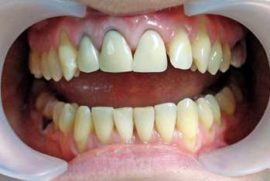 Inability to adjust color during operation. The color of ceramic spraying does not change over time, but natural enamel is quite capable of darkening, as a result of which the difference between natural and artificial crowns becomes noticeable. This disadvantage can be compensated for by a careful selection of the shade of the ceramic coating and regular professional brushing of teeth in dentistry - once every six months. The second problem associated with color is the inability of the metal at the base of the crown to transmit light, which makes it noticeable against the background of natural glossy teeth (see photo). In connection with this feature, cermet is used only for paired prosthetics of the front incisors.
Inability to adjust color during operation. The color of ceramic spraying does not change over time, but natural enamel is quite capable of darkening, as a result of which the difference between natural and artificial crowns becomes noticeable. This disadvantage can be compensated for by a careful selection of the shade of the ceramic coating and regular professional brushing of teeth in dentistry - once every six months. The second problem associated with color is the inability of the metal at the base of the crown to transmit light, which makes it noticeable against the background of natural glossy teeth (see photo). In connection with this feature, cermet is used only for paired prosthetics of the front incisors.- The risk of the metal frame coming out when the gingival margin is lowered. With periodontal diseases, the gums may fall, which is fraught with the emergence of the metal base of the pin from under the gums. To restore the aesthetics of the structure, its restoration in dentistry will be required.
- Inability to prosthetize teeth with a small height of natural crowns and abnormally small sizes of lower incisors.
Some disadvantages of ceramic-metal crowns become pluses if products are placed on all teeth. These parameters include color stability and high strength ceramic coating.
With the full replacement of natural crowns with cermet ones, one should seriously approach the choice of a dental clinic, since the comfort and safety of their operation depend on the quality of manufacture and fitting of prostheses.
Prosthetics procedure
The quality of the prosthetics depends on how long the ceramic-metal crown will serve. Installation of the prosthesis is carried out in several stages:
- The first step is the preparation of the oral cavity and the choice of the type of prosthesis. The preparation is to treat tooth decay and periodontal disease.
- After the rehabilitation of the oral cavity, the preparation of supporting teeth, their turning and depulpation are carried out. The steps used for turning are determined by the type of crown, the place of prosthetics, the condition of the teeth and gums.
- When the dentist makes an impression of the jaw, he will send it to the dental laboratory for the manufacture of the prosthesis. How long it takes to make it depends solely on the workload of the laboratory. On average, it takes about a week.
- The finished prosthesis is fixed on temporary cement to make sure that it is anatomically accurate and does not prevent the patient from eating and talking.
If the ceramic-metal teeth do not cause discomfort, after 3 months the dentist will remove them, clean them and fix them permanently. After final fixation, removing the prosthesis without damaging it can only be done using ultrasound.

